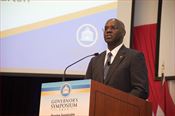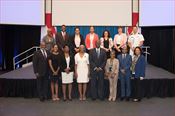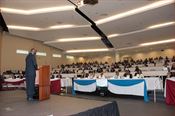Shaping Sustainable Economic Recovery Through Resiliency Strategies Opening Address By The Governor
- jun 21, 2019
Ladies and Gentlemen,
Good Morning,
It gives me, also on behalf of Marie-Louise, great pleasure to see so many of you here today and to welcome you to the eight annual Governor’s Symposium with the theme “Shaping Sustainable Economic Recovery in the Caribbean – Challenges and Opportunities”.
In particular I acknowledge the presence of Prime Minister Leona Romeo-Marlin who will be addressing you today as well as the Chairlady of Parliament Mrs. Wescot, the 1st Vice President of the Collectivité Ms. Damaseu, and the Dean of AUC Dr. Delgado.
I am in particular pleased to recognize and extend a special welcome to my honored guests: our keynote speaker, Ms. Marla Dukharan, from Bitt Inc in Trinidad, our featured speaker Ms. Tahseen Sayed, from the World Bank in Washington DC, our featured speaker Dr. Justin Ram, from the Caribbean Development Bank in Barbados as well as our local featured speaker Mr. Claret Connor from the National Recovery and Program Bureau. Your presence at this Governor’s Symposium is highly valued.Ladies and Gentlemen,
In 1910 poet Ella Wheeler Wilcox wrote: “Tis the set of the sails, And not the gales, Which tells us the way to go”. In the context of the impact of hurricanes Irma and Maria, it is the set of our policy that shapes our economic recovery. I shall therefore in the next few minutes, to set the stage for the symposium, share my thoughts with you on the topic “Shaping Sustainable Economic Recovery through resiliency strategies”.
Ladies and Gentlemen,
To appreciate the scope and magnitude of the recovery effort we must take stock of the extent and nature of the devastation and impact of hurricanes Irma and Maria. Because time does not permit me to give you a complete overview and analysis, I shall, to help frame the discussion for today, only highlight a few salient points.At the November 2017 CARICOM Conference organized with support from the UNDP it was estimated that recovery costs surpass USD.5 billion. In some countries the impact is estimated at 3.5 times GDP. At the conference, CARICOM Secretary-General Irwin LaRocque stated, and I QUOTE: “The magnitude of the reconstruction will require significant levels of financing which we are unable to generate on our own. Countries are highly indebted, with limited access to financing due to their middle income status”, UNQUOTE. At the conference UN Secretary-General Antonio Guterres stated and I QUOTE: “We need a new generation of infrastructure that is risk-informed, to underpin resilient economies, communities and livelihoods”, UNQUOTE.
Pre-Irma, Sint Maarten’s economy generated a per capita income of USD.26,163, one of the highest in the region. The underlying economic activity was in large part fueled by over 2.2 million cruise (1.7M) and stayover (0.5M) visitors a year.
The passing of hurricane Irma exposed and underscored local and external vulnerabilities of our island’s economic sustainability. According to the January 2019 IMF country report, Hurricanes Irma and Maria caused damages and losses on Sint Maarten of USD.2.7 billion , that is over 250% of GDP. Damages which are still visible in critical public and private infrastructure such as, schools, our airport, water storage facilities and several hotels . The devastation led to a decline in the number of stayover and cruise visitors from about 2.2 million in 2016 to about 1.8 million in 2018. As a result, foreign exchange revenues dropped by USD.401 million or 47% in 2018 compared to 2016
These developments resulted in an estimated cumulated contraction in the economy of over 13% between 2017 and 2018 (see graph 1). These losses in turn resulted in an average loss in individual annual income of USD2,500, as reflected in the estimated drop in per capita income .The fiscal position deteriorated as a result of these developments, with a budget deficit of USD40 million in 2017 and USD.50 million in 2018. And the debt-to-GDP ratio increased by almost 10 percentage points to an estimated 43.6%.
Ladies and gentlemen,
Faced with this economic reality and recognizing that the next hurricane or shock can hit anytime, the community of Sint Maarten has been preoccupied with the challenge of: how to recover the socio-economic losses and avoid or limit future damages and losses in the event of a next hurricane or some other external shock? Placed in a broader historical analytic perspective it is noteworthy that this challenge is the result of the vulnerability of our socio-economic development to external shocks, over which we have no control. In the last quarter of a century our island’s economy was impacted in varying degrees by several major events: hurricane Luis in 1995 which led to a significant damages and losses. Foreign exchange earning from tourism declined by almost USD.100 million (appr.24%) in 1995 and 1996 combined (see graph 2b); the 911 terrorist attacks in 2001 which resulted in major losses in economic activity; the third oil crisis with a peak in oil prices at USD.147.30 in July of 2008 (see graph 3) and the accompanying increase in costs and loss of disposable incomes; and most recently the impact of hurricane Irma in 2017 as outlined. Looking ahead we are faced with the threats of climate change in the form of more severe hurricanes and the risks of sea-level rise which is projected to result in Philipsburg, Simpson bay and other low-lying areas be submerged by the sea. With this prospect it would seem that our regions fate is one of a revolving door of external shocks and recovery. That is if we do not set our sail to address the core aspect of our challenge: vulnerability.
Taking that into account it is paramount that any policy response to external shocks must address the level of vulnerability of our economy. In broader terms it means that if we are to achieve the 2030 agenda of sustainable development goals we must address the vulnerability of our people, environment, infrastructure and economy. It is in this context important to underscore the special relationship between economic vulnerability, resiliency and sustainability. It is widely accepted in the that resilient countries or regions are able to ensure economic sustainability and welfare because their economies are less vulnerable and/or are able to recover from economic shocks quite quickly.
Our vulnerability therefore calls for special focus on resiliency strategies in the recovery agenda. A closer look at the challenge as a result of Irma shows that it is comprised of several dimensions:
- First, the rebuilding of the physical infrastructure such as the airport, hotels, utility networks, businesses and homes;
- Second, the recovery of losses in revenue, income and jobs to pre-Irma levels and beyond;
- Third, ensuring that rebuilding and recovery are resilient against future shocks; and
- Fourth, the existence of the gap between investment needs and available financing.Ladies and Gentlemen,
Considering the recovery efforts and plans of government, businesses and households as well as the support from the Dutch government, in the form of liquidity support and the Euro 470 million Word Bank administered Recovery and Resiliency Trust Fund, it is important to recognize that Sint Maarten have come a long way since the passing of Irma on September 6, 2017. In the one year and nine months since the passing of hurricane Irma, much of the damaged infrastructure has been rebuild or is under reconstruction. This was funded in large part with insurance payouts, bank financing, depletion of private savings, drawdown of government reserves and Dutch funding. At the same time there is still quite some work to be done and even more to build resiliency. Areas for consideration in building resilience and by no means complete are:
• First, investments in airport and seaport resilience to secure the transport of goods and persons necessary for the survivability, recovery and sustainable functioning of the economy.
• Second, investments in energy resilience by completing the underground cabling program and by investing in renewable energy generation such as solar. This with the objective of securing an even quicker restoration of electricity in the aftermath of hurricanes.
• Third, investing in environmental protection by implementing sustainable waste management solutions.
• Fourth, investments in communications resilience considering the importance of communication for disaster management and for the operation of economies in the digital age; and
• Fifth, improving social resilience by investing in the resiliency of the population and properties in underprivileged neighborhoods.It is evident that there is no quick fix to building economic resiliency. It can however, be concluded that the challenge we face after Irma holds within it the opportunity to invest in the enhancement of our socio-economic resilience and with that the improvement of the wellbeing of our population. It holds within it the opportunity to set our sails and plan for sustainable recovery and development. Investing in socio-economic resilience and sustainability is also the best approach to bridging the financing gap we face as a country and a region.
Ladies and gentlemen,
In closing, I will like to leave you with the following thought.
Hurricane Irma caused cumulative losses in GDP of 13% in 2017 and 2018 and a loss in average individual income of USD.2500. Going forward and all things equal,
• if the economy grows by 1% annually it will take us about 11 years to make up the losses;
• if the economy grows by 2% annually, that is about the regional average, it will take us about 6 years to make up the losses;
• if the economy grows by 3% annually it will take us about 4 years to make up the losses;
It is evident that we, all of us, government, businesses and individuals, have a joint responsibility to take steps to make our country more resilient against the impact of external shocks.The way forward will therefore require a fundamental shift in our current development model. The shift is the move from a primarily single focused economic development model to a multi-facetted sustainable development model.
Critical in that context is the need to recognize the intrinsic value and strength of our islands human and natural resources as the foundation for building necessary partnerships in the interdependent global community we live in. I am in that regard encouraged by the efforts of government to work in cooperation with NGOs with support from the Netherlands and the World Bank. It is as such in view of the imperative to build economic resilience for sustainable economic recovery that I organized this symposium.
I therefore look forward to hearing the views of the keynote speaker and featured speakers as well as your questions on this relevant topic for Sint Maarten and the region. That as we navigate our way to rebuild and recover.
For in the words poet Ella Wheeler Wilcox:
“Tis the set of the sails,
And not the gales,
Which tells us the way to go”With that I hereby declare this symposium open and wish you an enjoyable and fruitful symposium.
Thank you, God bless you and May God bless Sint Maarten and protect its coast!


